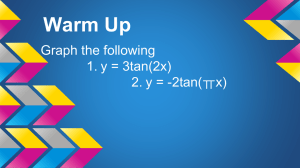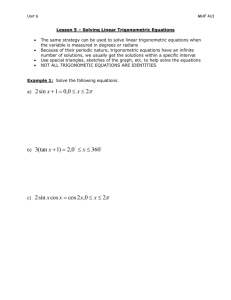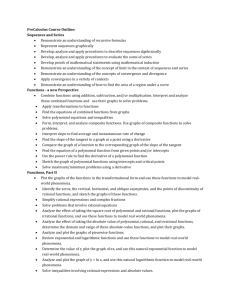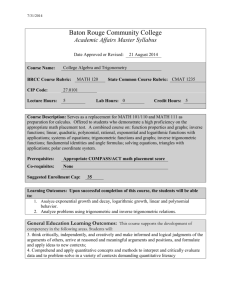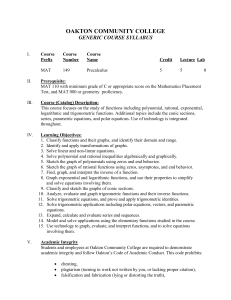Pre-Calculus 30
advertisement
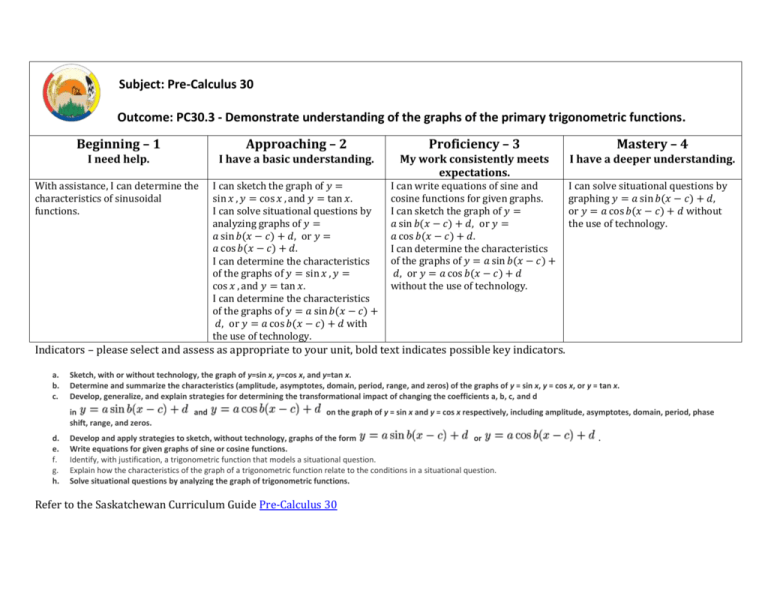
Subject: Pre-Calculus 30 Outcome: PC30.3 - Demonstrate understanding of the graphs of the primary trigonometric functions. Beginning – 1 Approaching – 2 Proficiency – 3 Mastery – 4 I need help. I have a basic understanding. My work consistently meets expectations. I have a deeper understanding. With assistance, I can determine the characteristics of sinusoidal functions. I can sketch the graph of 𝑦 = sin 𝑥 , 𝑦 = cos 𝑥 , and 𝑦 = tan 𝑥. I can solve situational questions by analyzing graphs of 𝑦 = 𝑎 sin 𝑏(𝑥 − 𝑐) + 𝑑, or 𝑦 = 𝑎 cos 𝑏(𝑥 − 𝑐) + 𝑑. I can determine the characteristics of the graphs of 𝑦 = sin 𝑥 , 𝑦 = cos 𝑥 , and 𝑦 = tan 𝑥. I can determine the characteristics of the graphs of 𝑦 = 𝑎 sin 𝑏(𝑥 − 𝑐) + 𝑑, or 𝑦 = 𝑎 cos 𝑏(𝑥 − 𝑐) + 𝑑 with the use of technology. I can write equations of sine and cosine functions for given graphs. I can sketch the graph of 𝑦 = 𝑎 sin 𝑏(𝑥 − 𝑐) + 𝑑, or 𝑦 = 𝑎 cos 𝑏(𝑥 − 𝑐) + 𝑑. I can determine the characteristics of the graphs of 𝑦 = 𝑎 sin 𝑏(𝑥 − 𝑐) + 𝑑, or 𝑦 = 𝑎 cos 𝑏(𝑥 − 𝑐) + 𝑑 without the use of technology. I can solve situational questions by graphing 𝑦 = 𝑎 sin 𝑏(𝑥 − 𝑐) + 𝑑, or 𝑦 = 𝑎 cos 𝑏(𝑥 − 𝑐) + 𝑑 without the use of technology. Indicators – please select and assess as appropriate to your unit, bold text indicates possible key indicators. a. b. c. Sketch, with or without technology, the graph of y=sin x, y=cos x, and y=tan x. Determine and summarize the characteristics (amplitude, asymptotes, domain, period, range, and zeros) of the graphs of y = sin x, y = cos x, or y = tan x. Develop, generalize, and explain strategies for determining the transformational impact of changing the coefficients a, b, c, and d in shift, range, and zeros. d. e. f. g. h. and on the graph of y = sin x and y = cos x respectively, including amplitude, asymptotes, domain, period, phase Develop and apply strategies to sketch, without technology, graphs of the form or Write equations for given graphs of sine or cosine functions. Identify, with justification, a trigonometric function that models a situational question. Explain how the characteristics of the graph of a trigonometric function relate to the conditions in a situational question. Solve situational questions by analyzing the graph of trigonometric functions. Refer to the Saskatchewan Curriculum Guide Pre-Calculus 30 . Subject: Pre-Calculus 30 Outcome: PC30.4 - Demonstrate understanding of first- and second-degree trigonometric equations. Beginning – 1 Approaching – 2 Proficiency – 3 Mastery – 4 I need help. I have a basic understanding. My work consistently meets expectations. I have a deeper understanding. With assistance, I can determine approximate solutions for first degree trigonometric equations. I can determine approximate solutions for first degree trigonometric equations. I can determine exact value solutions to first degree trigonometric equations. I can determine exact value and approximate solutions to second degree trigonometric equations. I can express solutions in general form. I can determine and correct errors in trigonomentric equasions, and justify my solutions. I can explain and justify relationships of trigonometric solutions to the zeros of the functions. Indicators – please select and assess as appropriate to your unit, bold text indicates possible key indicators. a. b. c. d. e. f. Verify, with or without technology, whether or not a value is a solution to a particular trigonometric equation. Develop and apply strategies for determining algebraically the exact form of the solution to a trigonometric equation. Determine, using technology, the approximate solution in degrees and radians of a trigonometric equation in a restricted domain. Explain the relationship between the general solution of trigonometric equations to the zeros of the related trigonometric functions limited to sine and cosine functions. Determine, using technology, the general solutions for trigonometric equations. Analyze solutions for given trigonometric equations to identify errors, and correct if necessary. Refer to the Saskatchewan Curriculum Guide Pre-Calculus 30 Subject: Pre-calculus 30 Outcome: PC30.5 - Demonstrate understanding of trigonometric identities including: reciprocal identities quotient identities Pythagorean identities sum or difference identities (restricted to sine, cosine, and tangent) double-angle identities (restricted to sine, cosine, and tangent) Beginning – 1 Approaching – 2 Proficiency – 3 Mastery – 4 I need help. I have a basic understanding. My work consistently meets expectations. I have a deeper understanding. With assistance, I can verify a trig statement for a given value I can verify a trig statement for a given value I can prove complex identities without errors. I can determine non- permissible values of trig identities. With assistance, I can prove “one step” trig identities algebraically. Prove “ one step” trig identities algebraically. I can determine the exact values of trig ratios using sum, difference and double angle identities. I can prove any trig identity With assitance, I can determine the exact values of trig ratios using sum, difference and double angle identities. My process is correct, but may make simplifying errors. Indicators – please select and assess as appropriate to your unit, bold text indicates possible key indicators. a. b. c. d. e. f. g. Explain the difference between a trigonometric identity and a trigonometric equation. Verify numerically (using degrees or radians) whether or not a trigonometric statement is a trigonometric identity. Critique statements such as "If three different values verify a trigonometric identity, then the identity is valid". Determine, with the use of graphing technology, the potential validity of a trigonometric identity. Determine the non-permissible values of a trigonometric identity. Develop, explain, and apply strategies for proving trigonometric identities algebraically. Explain and apply strategies for determining the exact value of a trigonometric ratio by using sum, difference, and double-angle identities. Refer to the Saskatchewan Curriculum Guide Pre-Calculus 30 Subject: Pre-Calculus 30 Outcome: PC30.6 - Demonstrate an understanding of operations on, and compositions of, functions. Beginning – 1 Approaching – 2 Proficiency – 3 Mastery – 4 I need help. I have a basic understanding. My work consistently meets expectations. I have a deeper understanding. I need help to determine values of functions. I can determine the value for a composition of functions at a particular point. I can write the equation of a function that results from the sum, difference, product, or quotient of two or more functions. I can write the equation of a function that results from the composition of functions. I can sketch the graph of a function that is the sum, difference, product, or quotient of two or more functions, or the composition of two functions. I can determine the domain and range of a function that is the sum, difference, product, or quotient of two other functions. I can determine the domain and range of a function that is the composition of two or more functions. I can write a function as the sum, difference, product, quotient, or composition of two or more functions. Indicators – please select and assess as appropriate to your unit, bold text indicates possible key indicators. a. b. c. d. e. Sketch the graph of a function that is the sum, difference, product, or quotient of two functions whose graphs are given. Write the equation of a function that results from the sum, difference, product, or quotient of two or more functions. Develop, generalize, explain, and apply strategies for determining the domain and range of a function that is the sum, difference, product, or quotient of two other functions. Write a function as the sum, difference, product, or quotient (or some combination thereof ) of two or more functions. Develop, generalize, explain, and apply strategies for determining the composition of two functions: o o f. g. o Develop, generalize, explain, and apply strategies for evaluating a composition of functions at a particular point. Develop, generalize, explain, and apply strategies for sketching the graph of composite functions in the form: o o o h. i. where the equations or graphs of f(x) and g(x) are given. Write a function as a composition of two or more functions. Write a function by combining two or more functions through operations on, and compositions of, functions. Refer to the Saskatchewan Curriculum Guide Pre-Calculus 30 Subject: Pre-Calculus 30 Outcome: P30.10 - Demonstrate understanding of polynomials and polynomial functions of degree greater than 2 (limited to polynomials of degree ≤ 5 with integral coefficients). Beginning – 1 Approaching – 2 Proficiency – 3 Mastery – 4 I need help. I have a basic understanding. My work consistently meets expectations. I have a deeper understanding. With assistance or the use of technology, I can determine the multiplicity, factors/zeroes of the function, leading coefficient, degree and constant term of a polynomial function, without technology. I can determine the multiplicity, factors/zeroes of the function, leading coefficient, degree and constant term of a polynomial function, without technology. I can sketch the graph of a polynomial function, without technology, by determining the multiplicities, factors/zeroes of the function, leading coefficient, degree and constant term. I can create a possible polynomial function, given a graph or given the characteristics of a polynomial function. Indicators – please select and assess as appropriate to your unit, bold text indicates possible key indicators. a. Develop, generalize, explain, and apply long division for dividing polynomials by binomials of the form x - a, a∈ 𝑰. b. Compare long division of polynomial expressions by binomial expressions to synthetic division, and explain why synthetic division works. c. Divide a polynomial expression by a binomial expression of the form x - a, a∈ 𝑰 using synthetic division. d. Explain the relationship between the linear factors of a polynomial expression and the zeros of the corresponding polynomial function. e. Generalize, through inductive reasoning, the relationship between the remainder when a polynomial expression is divided by x - a, a∈ 𝑰 and the value of the polynomial expression at x = a (The Remainder Theorem). f. Explain and apply the factor theorem to express a polynomial expression as a product of factors. g. Categorize, with justification, a set of functions into polynomial functions and non-polynomial functions. h. Analyze graphs of polynomial functions to determine the impact of changing the values of the constant term and leading coefficient in the equation of a polynomial function with respect to the graph of the function. i. Generalize and apply strategies for graphing polynomial functions of odd or even degree. j. Explain the relationship between: • the zeros of a polynomial function • the roots of the corresponding polynomial equation • the x-intercepts of the graph of the polynomial function. k. Explain, and apply strategies for determining the behavior of the graph of a polynomial function at zeros with different multiplicities. l. Sketch, with or without the use of technology, the graph of a polynomial function. m. Solve situational questions by modeling the situations with polynomial functions and analyzing the graphs of the functions. Refer to the Saskatchewan Curriculum Guide Pre-Calculus 30 Subject: Pre-Calculus 30 Outcome: P30.11 - Demonstrate understanding of radical and rational functions with restrictions on the domain. Beginning – 1 Approaching – 2 Proficiency – 3 Mastery – 4 I need help. I have a basic understanding. My work consistently meets expectations. I have a deeper understanding. With assistance, I can apply transformations to sketch the graph of a radical and rational function and compare the domain and range of the two functions, with the use of technology. I can apply transformations to sketch the graph of a radical and rational function and compare the domain and range of the two functions, with the use of technology. I can apply transformations to sketch the graph of a radical and rational function and compare the domain and range of the two functions, without the use of technology. I can create the equation for a radical function and a rational function from a graph. I can determine where a rational function has an asymptote or hole, without technology. Indicators – please select and assess as appropriate to your unit, bold text indicates possible key indicators. a. Sketch the graph of the function y = √ x using a table of values, and state the domain and range of function. b. Develop, generalize, explain, and apply transformations to the function y = √x to sketch the graph of y - k = a√b(x - h) . c. Sketch the graph of the function y = √f(x) given the graph of the function y = f(x), and compare the domains and ranges of the two functions. d. Describe the relationship between the roots of a radical equation and the x-intercepts of the graph of the corresponding radical function. e. Determine, graphically, the approximate solutions to radical equations. f. Sketch rational functions, with and without the use of technology. g. Explain the behaviour (shape and location) of the graphs of rational functions for values for the dependent variable close to the location of a vertical asymptote. h. Analyze the equation of a rational function to determine where the graph of the rational function has an asymptote or a hole, and explain why. i. Match a set of equations for rational and radical functions to their corresponding graphs. j. Describe the relationship between the roots of a rational equation and the x-intercepts of the graph of the corresponding rational function. k. Determine graphically an approximate solution to a rational equation. l. Critique statements such as “Any value that makes the denominator of a rational function equal to zero will result in a vertical asymptote on the graph of the rational function”. Refer to the Saskatchewan Curriculum Guide Pre-Calculus 30 Subject: Pre-Calculus 30 Outcome: P30.12 - Demonstrate understanding of permutations, including the fundamental counting principle. : P30.13 - Demonstrate understanding of combinations of elements, including the application to the binomial theorem. Beginning – 1 Approaching – 2 Proficiency – 3 Mastery – 4 I need help. I have a basic understanding. My work consistently meets expectations. I have a deeper understanding. I can solve basic situational questions that involve one strategy, such as Fundamental Counting Principle, factorial notation, permutations or combinations. I can solve situational questions that involve conditions, restrictions and multiple cases. I can solve equations for n or r, using the formulas nPr or nCr. With assistance, I can solve basic situational questions that involve one strategy, such as Fundamental Counting Principle, factorial notation, permutations or combinations. I can determine the number of terms in the expansion of a binomial. I can expand a binomial or determine a specific term using The Binomial Theorem. Indicators – please select and assess as appropriate to your unit, bold text indicates possible key indicators. P30.12: a. Develop and apply strategies, such as lists or tree diagrams, to determine the total number of choices or arrangements possible in a situation. b. Explain why the total number of possible choices is found by multiplying rather than adding the number of ways the individual choices can be made. c. Provide examples of situations relevant to self, family, and community where the fundamental counting principle can be applied to determine the number of choices or arrangements possible. d. Create and solve situational questions that involve the application of the fundamental counting principle. e. Count using graphic organizers the number of ways of arranging the elements of a set in a row. f. Develop, generalize, explain, and apply strategies, including the use of factorial notation, to determine the number of permutations possible if n different elements are taken n or r at a time. g. Explain why n must be greater than or equal to r in the notation nPr. h. Solve equations that involve nPr. notation, such as nP2 = 30. i. Develop, generalize, explain, and apply strategies for determining the number of permutations possible when two or more elements in the set are identical. (non distinguishable) P30.13: a. Explain, with examples, how to distinguish between situations that involve permutations and those that involve combinations. b. Develop, generalize, explain, and apply strategies for determining the number of ways that a subset of k elements can be selected from a set of n different elements. c. Develop, generalize, explain, and apply strategies to determine combinations of n different elements taken r at a time in situational questions. d. Explain why n must be greater than or equal to r in the notation nCr. or (n¦r) . e. Prove that nCr. =nCn-r or (n¦r) = (n/n - r). f. Solve equations involving combinations (e.g., nC2 =15 or (n¦2) = 15). g. Explore and describe patterns found within Pascal’s triangle, including the relationship between consecutive rows. h. Explore and describe the relationship between the coefficients of the terms in ( x + y)n, and combinations. i. Develop, generalize, explain, and apply strategies for expanding (x + y)n, n < 4 and n E N and for determining specific terms within a particular expansion. Refer to the Saskatchewan Curriculum Guide Pre-Calculus 30
